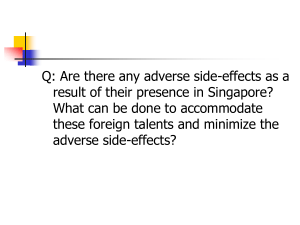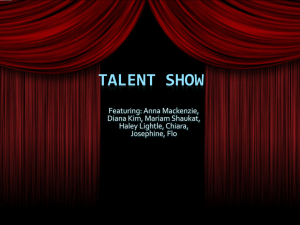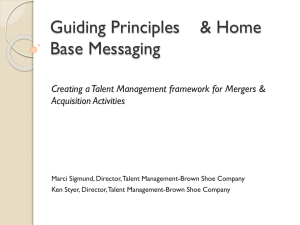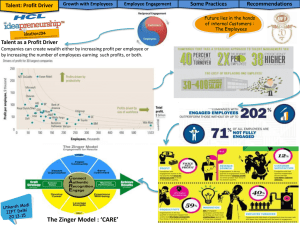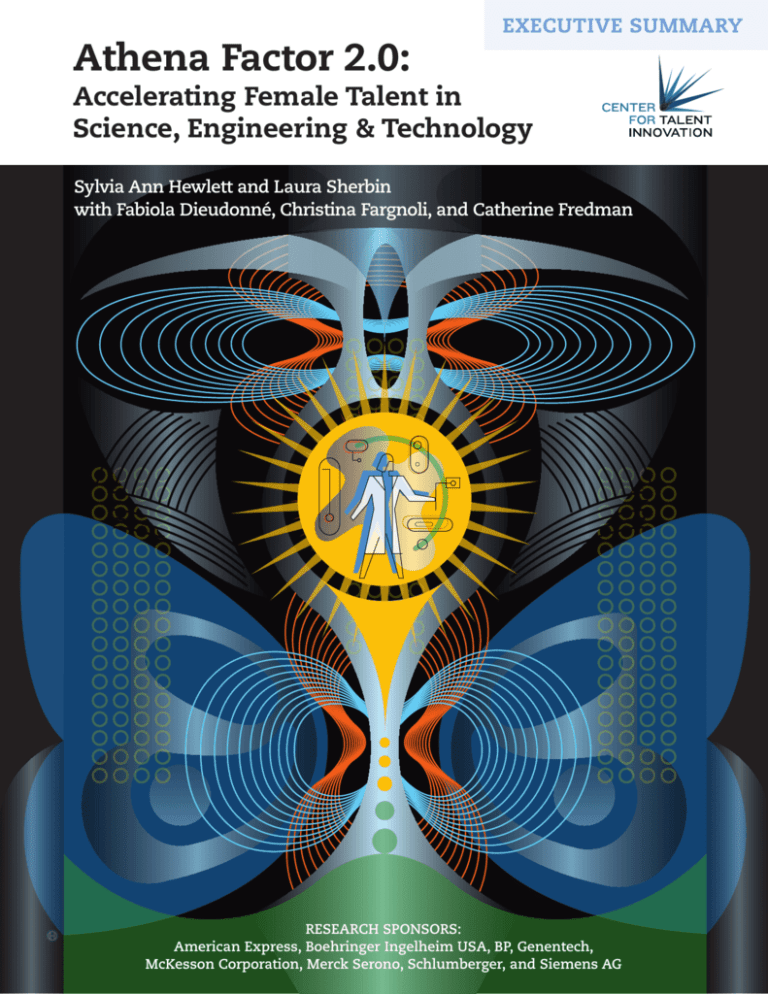
Athena Factor 2.0:
EXECUTIVE SUMMARY
Accelerating Female Talent in
Science, Engineering & Technology
Sylvia Ann Hewlett and Laura Sherbin
with Fabiola Dieudonné, Christina Fargnoli, and Catherine Fredman
RESEARCH SPONSORS:
American Express, Boehringer Ingelheim USA, BP, Genentech,
McKesson Corporation, Merck Serono, Schlumberger, and Siemens AG
Executive Summary
In 2008, when we published The Athena Factor: Reversing the Brain Drain in Science, Engineering, and
Technology, our data showed that while the female talent pipeline in SET was surprisingly robust,
women were dropping out of the field in droves. Over time, fully 52 percent of highly qualified
women working for SET companies quit their jobs, driven out by hostile work environments,
isolation, extreme work pressures, and a lack of clarity surrounding career paths.
WOMEN WHO
SAY THEY FEEL
STALLED
27%
U.S.
Five years later, the situation has evolved in ways both promising and frustrating. The
demand for SET talent is intensifying at the same time that the supply of scientists,
engineers, and technologists is dwindling: post-9/11 security concerns have
reduced the number of H-1B visas (which allow foreign nationals to work in the
United States), and rapid growth in Asia has created a reverse brain drain of
highly qualified Indian and Chinese scientists and engineers who are returning
home after completing their education in the United States. This bodes
well for women. Yet many of the barriers we documented in our first report
continue to daunt and demoralize women as they seek to fill these gaps.
29%
23%
45%
Brazil
China
In this report, we revisit the SET landscape—expanded to include Brazil,
China, and India as well as the U.S.—to determine what has changed for the
better and to offer solutions for what has resisted change. The good news:
the pipeline of global female talent in SET remains rich and deep, with women
India
being the majority of SET college graduates in many key geographies. They’re
ambitious, eager to be promoted, and dedicated to their professions: 80 percent of
U.S., 87 percent of Brazilian, 90 percent of Chinese and 93 percent of Indian SET women
say they love their work. However, a sizable proportion say they feel stalled and say they are
likely to quit their jobs within a year.
The fundamental reasons haven’t changed. While no longer subjected to
overt bias, women continue to face powerful “antigens” in SET corporate
environments. However, our new data identifies newly revealed nuances.
These include:
Hostile macho cultures. Women in SET are marginalized by lab-coat, hard-hat, and
geek workplace cultures that are often exclusionary and promulgate bias.
Isolation. SET women no longer find themselves the sole female on a team or at a
site. Yet they still feel excluded from “buddy networks” among their peers and
lack female role models.
Scarcity of effective sponsors. Although SET women have sponsors, they don’t reap
the benefits to the degree that their male colleagues do. The “sponsor effect”
(the differential in satisfaction with career progression for individuals with
sponsors vs. those without) is 22 percent for U.S. SET women versus 32 percent
WOMEN WHO SAY
THEY ARE LIKELY
TO QUIT WITHIN A
YEAR
32%
22%
U.S.
Brazil
30%
20%
China
India
30% of women’s ideas get
green-lighted for development
vs. 37% of men’s
25% of women’s ideas
get realized/implemented
vs. 30% of men’s
for men, 19 percent for Brazilian SET women versus 42 percent for men, and 21 percent
for Chinese SET women versus 58 percent for men.
Difficulty with executive presence. SET women struggle to decipher and embody leadership
attributes, and receive little useful feedback to correct this perception.
These antigens contribute to an environment of subtle, unspoken bias that
makes it more difficult for SET women to assume leadership roles. They
also suppress, as CTI’s 2013 Innovation, Diversity and Market Growth report
makes clear, innovative potential. Only 38 percent of women get their ideas
endorsed by leadership, compared to 44 percent of men (in SET companies
in the U.S.).
46%
of U.S. SET women believe
senior management
more readily sees men as
“leadership material”
Looking at the barriers to SET women’s advancement through a lens
refined by our recent studies in sponsorship, executive presence,
and innovation, we see promising levers for change. The most obvious solution:
WITH A
sponsorship. Sponsors help their protégés crack the unwritten code of executive
SPONSOR SET
presence, improving their chances of being perceived as leadership material. Most
WOMEN ARE:
important to the companies employing them, sponsors help women get their
ideas heard.
37%
more likely to ask
for a raise
(37% vs. 27%)
and
22%
more likely to be
satisfied with
their rate of
promotion
(73% vs. 60%)
This study offers road maps for both ambitious SET women and human
resource professionals seeking to correct for some of the inequities that beset
this critical talent pool. Five company initiatives—some still in an early
experimental stage, some fully developed and delivering solid results—offer
templates to ensure that many more women not only stay in SET careers,
but also progress to realize their full potential. Our research shows that
when SET women are fully engaged, and when leadership creates the
speak-up culture wherein their ideas might be heard, companies enjoy
a “diversity dividend” that translates into increased market share and
entry into altogether new markets. To remain globally competitive, every
company needs to harness the innovative potential of its highly qualified
female workforce, but nowhere is that imperative greater than in the science,
engineering, and technology sectors.
WITH A SPONSOR SET WOMEN ARE:
70%
119% 200% (51% vs. 30%) more likely
to have their ideas endorsed
(46% vs. 21%) more likely
to see them developed
(39% vs. 13%) more likely
to see them implemented
CTI’s flagship project is the Task
Force for Talent Innovation—a
private-sector consortium focused
on helping organizations leverage
their talent across the divides of
gender, generation, geography, and
culture. The 80 global corporations
and organizations that constitute
the Task Force—representing nearly
6 million employees and operating
in 192 countries around the world—
are united by an understanding
that the full utilization of the talent
pool is at the heart of competitive
advantage and economic success.
1841 Broadway, Suite 300, New York, NY 10023 | TalentInnovation.org
winer idea group
illustration: Hank Osuna
© 2014 Center for Talent Innovation. All rights reserved. Unauthorized reproduction or transmission of any part of this publication in any form or by any means, mechanical or electronic, is prohibited. The analyses and opinions represented
in this report are solely those of the authors.


